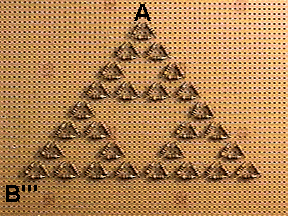
HandsOn 32 - Measuring the Resistance of the Sierpinski Gasket
In the following experiment, you will assemble a fractal resistor network that has the structure of the Sierpinski gasket. In order to assemble a large gasket, this experiment requires cooperation among many collaborators or class participants.
In a classroom setting, each student is provided with nine identical resistors (e.g., 1 kW is fine) and a 5 cm x; 5 cm circuit board (insulating fiberboard with holes punched in it) on which to mount the resistors. Each student group should be provided with an ohmmeter to measure electrical resistance.
 |
 |
 |
 |
The steps in this experiment for groups of three students are:
2. Each team of students should construct the circuit in Figure
8.9 by linking together the three circuits they made in Step 1.
Measure the resistance between points A and B'',
and record this value. All teams should now compare resistance
measurements to be sure that none of the assembled circuits are
defective.
3. Three teams should join their circuits together to build the
next generation of the gasket shown in Figure 8.10. Measure the
resistance between the outer vertices A and B''',
and record the value.
4. If the class is large enough (27 students), the process can
be repeated one more time to produce another generation of the
gasket. Again the resistance should be measured between the external
vertices, and recorded. (If the class is smaller than 27, perhaps
some students can build extra circuits.)
5. To analyze the data, plot on log-log paper the measured resistance
from vertex to vertex along the vertical axis vs. the number
of resistors along one side of the network (i.e., the vertex-to-vertex
distance) along the horizontal axis. Draw the best straight line
you can through these graphed points.
|
|